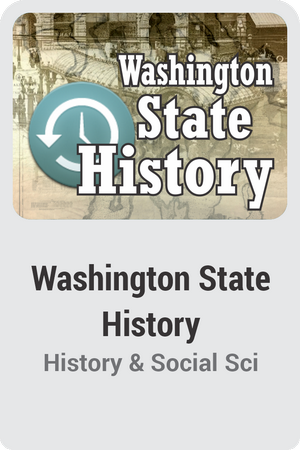
Course Overview:
Washington State History is a course designed to develop students’ awareness, appreciation, and understanding of Washington State and regions of the Pacific Northwest. The course of study covers the geography, history, government, people, economy, and culture of the state and surrounding region. Current issues of the area and state are also addressed.
The challenges of statehood, Washington’s role during the Progressive Era and wartime period, and modern developments in the state’s economy and culture are highlighted.
Local and tribal governments are examined to promote civic literacy and an understanding of civic duty and participation.
Through the course, themes like social history, effects of migration, principles of democratic government, and the relationship between humans and their environment are examined to allow students to connect the past and present with an appreciation of multiple perspectives.
A combination of instructional methods allows students to investigate Washington State’s geography, the cultures of its earliest people, and the impact of the creation of Washington Territory to foster an integrative approach to learning. Interactive timelines, videos, and learning checks support the course content and help students maintain interest in learning. Various assignments encourage reflection on what is taught in the course, and assessments reinforce the importance of what is taught and provide feedback for students regarding what they learned.
This course meets all the requirements for Washington State history.
Note: This course is not designed for ELL (English Language Learners) students. ELL students may enroll in this course ONLY if they have adequate mentor support at their home school and are able to fulfill all course requirements.
Prerequisites:
Syllabus:
Section 1 - Geography of Washington State
Objectives:
- Learn about the geography of Washington State, including the physical geography and cultural characteristics, location of places, and regions.
- Understand spatial patterns and they were impacted by natural processes and human activities.
- Consider forces that shaped the state with focus on human settlements and migration.
- Learn how human migration patterns impact the environment.
- Focus on two cases from different regions in Washington - Puget Sound Lowlands and the Okanogan Highlands.
- Analyze movement as a theme of geography.
- Consider national and global factors that changed Washington state.
Lessons:
- Introduction
- Relationship Between Human Population and the Physical World
- Impact of Human Interaction on the Environment
- Washington State Movement
- Washington State Movement of People
Section 2 - History of Washington State
Objectives:
In this section, you will learn to:
- Analyze positions and evidence supporting an issue or an event.
- Understand historical chronology.
- Analyze a major historical event and how it is represented on timelines from different cultural perspectives, including those of indigenous people.
- Realize multiple perspectives and interpretations of historical events.
- Explain, analyze, and develop an argument about how Washington state has been impacted by individuals and movements, as well as cultures and cultural groups.
- Analyze and understand how a historical event in Washington state history helps us understand contemporary issues and events.
- Explain the structure of and key ideals set forth in fundamental documents, including tribal treaties with the United States government.
- Understand the purposes and organization of tribal and international relationships and U.S. foreign policy.
- Recognize treaties are “the supreme law of the land” in the U.S.
- Explain elements of the agreements contained in one or more treaty agreements between Washington tribes and the United States.
- Use critical reasoning skills to analyze and evaluate claims.
- Analyze positions and evidence supporting an issue or an event.
- Evaluate the logic of reasons for a position on an issue or event.
Lessons:
- Early History of Washington State
- Territorial Conquest of Washington State
- Territory and Treaty Making 1854-1889 - Part 1
- Territory and Treaty Making - Part 2
- Walla Walla Treaty Council of 1855
- Progress and Development to Current Times - Part 1
- Progress and Development to Current Times - Part 2
- History of Immigrants in Washington State
Section 3 - Civics and Washington State Government
Objectives:
In this section you will:
- Learn about the core values of the United States and its origins via foundational documents such as the Declaration of Independence, the Constitution, and the Bill of Rights.
- Explore the Washington State Constitution and tribal treaties.
- Understand the purposes, organization, and function of governments, laws, and political systems at all levels of government.
- Consider Washington State’s diverse population and consider how minority needs are met.
- Explore international relationships and U.S. foreign policy.
- Analyze the impact of international agreements that have affected Washington state and recognize that, according to the U.S. Constitution, treaties are “the supreme law of the land.”
- Consider the legacy of treaties and international relationships.
- Learn about civic involvement and how to exercise political power at the state level.
Lessons:
- Civics Introduction
- Purpose, Organization, and Function of Governments, Laws, and Political Systems
- Tribal and International Relationships and Foreign Policy
- Civic Involvement
Section 4 - Economics of Washington State
Objectives:
In this section you will learn:
- What economics is and key terms associated with this field of study (i.e., factors of production, opportunity cost, scarcity, etc.)
- How Washington State's location and geography impact its economy
- Government’s role in the economy of Washington State through taxation, spending, and policy setting
- About the costs and benefits of trade policies to individuals, businesses, and society
- About alternative approaches to Washington state’s current economic issues
- How the concept of scarcity applies to Washington State
- About Washington State’s current economy
Lessons:
- Introduction to Economics - Part 1
- Introduction to Economics - Part 2
- Washington State Economy
- State Government and the Economy
- Economic Issues and Current Realities in Washington State
Section 5 - Culminating Project
Lessons:
- How to Write a Thesis Statement


